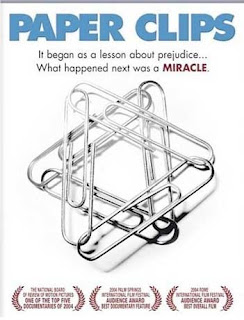Paper Clips
 The film, released in 2004, may not have the sophistication of well-made documentaries but the message it naively wishes to convey is heartfelt. This is one film that reminds us of the evils intolerance can bring: for example, during one of the worst times in history, intolerance caused the death of 6 million Jews and 5 million gypsies and homosexuals.
The film, released in 2004, may not have the sophistication of well-made documentaries but the message it naively wishes to convey is heartfelt. This is one film that reminds us of the evils intolerance can bring: for example, during one of the worst times in history, intolerance caused the death of 6 million Jews and 5 million gypsies and homosexuals.The film documents the efforts of three middle-school teachers of Whitwell, Tennessee, a small town of population 1600 consisting almost homogeneously of whites (all protestants), in their effort to be creative in teaching about intolerance that had led to the Holocaust.
It’s hard to imagine 6 million of anything, commented one student. That statement could be the starting point of the project for it led somehow to the idea of gathering six million paper clips as a tribute to the victims of the Holocaust. The project started slowly. Few clips were mailed to Whitwell from some parts of the country, although there were contributions from George Bush, Bill Clinton, Bill Cosby and Tom Hanks. Then the Washington Post and correspondent of Germany to the White House learned about the project; they helped and the result was overwhelming – 29 million clips were collected and a cattle car originally used to transport Jews into concentration camps was transported to Whitwell. The cattle car is now a memorial that houses 11 million clips representing 6 million Jews and 5 million gypsies and homosexuals who were victims of intolerance during the Holocaust.
Why paper clips? Paper clips were chosen because some people in Norway wore them on their lapels as a symbol of resistance against Nazi occupation during World War II. So, I'll look at paper clips differently from now on.
{August 18, 2009}


Comments